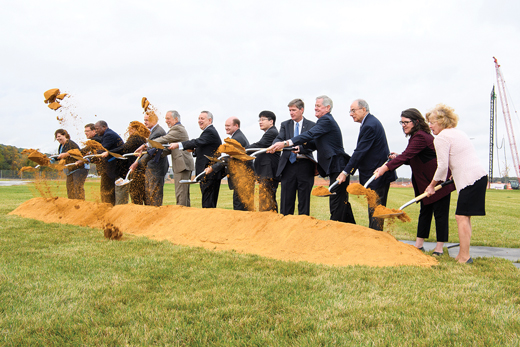Building the future with biopharmaceuticals

CAMPUS | It seemed like a pipe dream to Kelvin Lee, Gore Professor of Chemical and Biomolecular Engineering—this idea that the University of Delaware might find room for a place where innovation in biopharmaceuticals could happen. He wished for 60,000 square feet of space. But how could that work?
UD President Dennis Assanis had even bigger ideas.
“Why settle for 60,000 square feet,” Lee recalls Assanis saying, “when the University could build 200,000 square feet at the STAR Campus?”
Earlier this fall, the dream Lee once thought too expensive and too ambitious took shape in striking fashion, as 14 symbolic shovels plunged into a symbolic mound of dirt on UD's Science Technology and Advanced Research (STAR) Campus, the ceremonial start of construction on a six-story, $156 million Biopharmaceutical Innovation Building.
It will be a gateway, University officials hope, to a major role for Delaware in the emerging biopharmaceutical sector, where scientists and innovators will tackle some of the world's most vexing diseases—Alzheimer’s, Parkinson’s, diabetes, cancer, to name a few—and help to train a world-class workforce.
There, Lee will direct the extensive national initiative known as NIIMBL, the National Institute for Innovation in Manufacturing Biopharmaceuticals, with $70 million in federal funding from the National Institute for Standards and Technology (NIST) and millions more in support from UD and about 150 other partners in government, industry and academic sectors.
The Delaware Biotechnology Institute will relocate faculty, staff and three facilities to the new building—bio-imaging, bio-informatics and sequencing—and related UD-led life science research and technology programs will be housed there, too. Opening day is projected for January 2020.
It is another beginning on a 272-acre site that once was a gloomy symbol of economic despair in Delaware, where bulldozers razed the shuttered Chrysler automobile plant in 2009, ending more than 50 years of manufacturing. Combined with UD’s recent partnership with the DuPont Company and the state in launching Delaware Innovation Space Inc. at DuPont’s Experimental Station, it brings fresh hope to a state where 1,700 scientists were laid off last year.
At the building’s groundbreaking, U.S. Sen. Chris Coons called NIIMBL “one of those critical moments when you can see the bending of the arc of history toward a brighter and stronger future for Newark, for Delaware and for the world.”
NIIMBL’s mission, as announced last December by the U.S. Department of Commerce and NIST, is to accelerate innovation in biopharmaceutical manufacturing, support the development of standards that enable more efficient and rapid manufacturing capabilities, and educate and train the nation’s workforce, making the U.S. the world leader in the industry.
Biopharmaceuticals have shown great promise in medicine—relying on living cells instead of chemistry to treat disease. NIIMBL is meant to generate the innovative advances that will allow more rapid and flexible production with the precision needed to effectively meet healthcare needs and respond quickly to pandemics or other biological threats.
Article by Beth Miller




